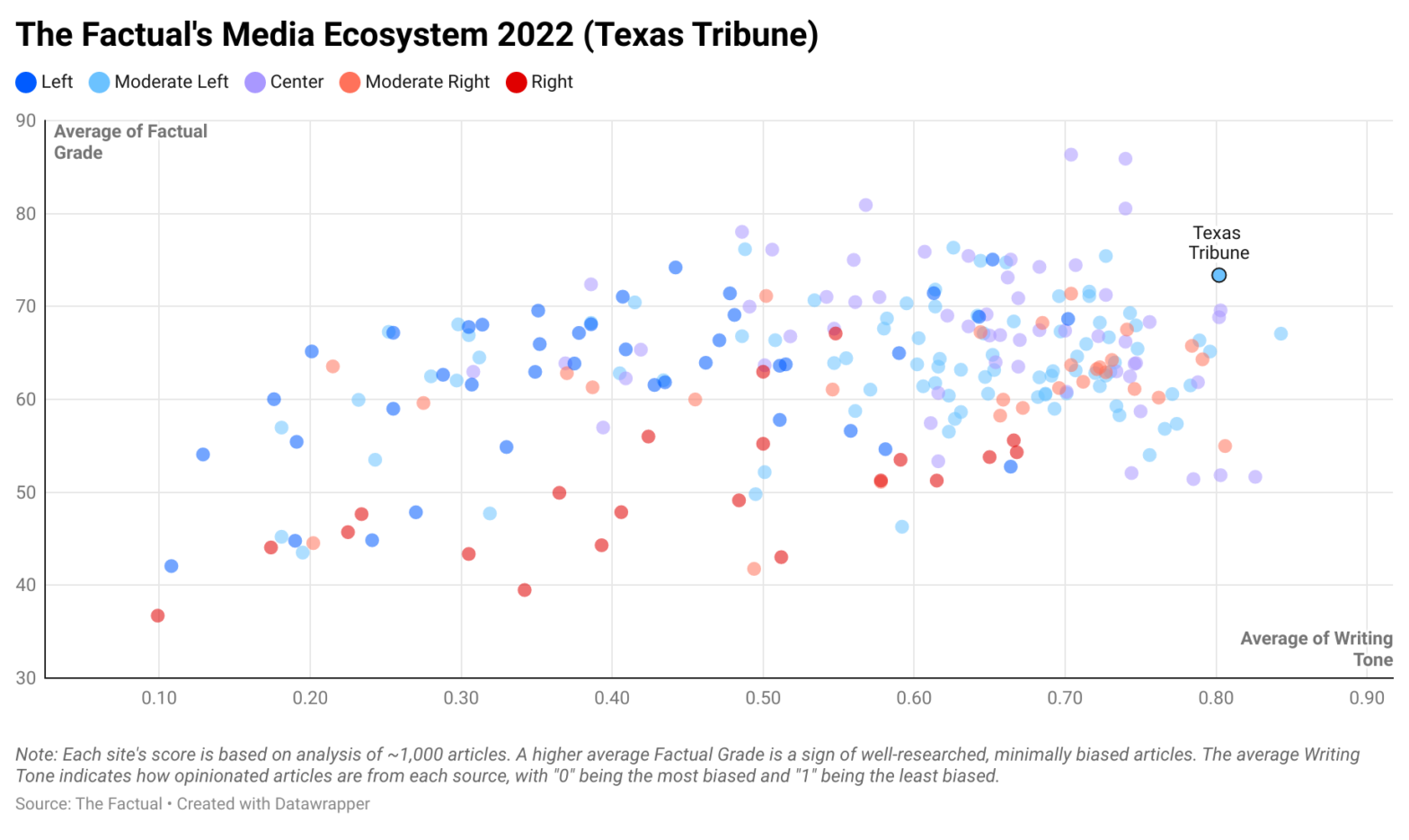The Texas Tribune advertises itself as the “only member-supported, digital-first, nonpartisan media organization that informs Texans … about public policy, politics, government and statewide issues.” The news site sets out to deliver fact-based, high-quality journalism accessible to all in a historically conservative state, and today faces accusations of a slight liberal bias. So, how reliable is news from the Texas Tribune, and how biased is its coverage?
How Does The Factual Rate News Sources?
The Factual analyzes more than 10,000 news stories every day to help readers find the most informative, least-biased articles. Our news-rating algorithm scores each article along four metrics: (1) cited sources and quotes, (2) publication history, (3) writing tone, and (4) author expertise. These scores combine in a weighted average we call a Factual Grade, which ranges from 0–100%. (See our How It Works page to learn more about our algorithm.)
For this study, we analyzed ~1,000 articles each from 240 news sources. The average Factual Grade for the entire dataset was 62.5%. Based on these averages, we can compare the performance of news sites across the media ecosystem. The entire dataset can be explored in greater detail here.
How Factual Is the Texas Tribune?
The Texas Tribune scored an average Factual Grade of 73.4%, placing it in the 92nd percentile of our dataset. In fact, this average puts the publication in the top 20 sources that we analyzed.
The newspaper receives such high scores due to its high standard of journalistic practices and its experienced team of journalists. For example, stories from the Texas Tribune pay consistent attention to providing adequate sourcing for stories, meaning articles are always accompanied by links to other high-quality stories on the topic. Likewise, stories are generally written in a highly unbiased manner, meaning reporters focus on naturally conveying news, not opinion. Finally, articles indicate substantial author expertise, signaling that its authors routinely cover the same topics.
Like any news source, scores for articles from the Texas Tribune vary widely based on factors like author expertise and cited evidence. For example, some scored above 90%, while others scored below 60%.
Please check your email for instructions to ensure that the newsletter arrives in your inbox tomorrow.
How Opinionated Is the Texas Tribune?
One of the metrics The Factual uses is the Writing Tone, which measures how opinionated the writing is in an article. For this metric, the algorithm looks for signs of subjective commentary (e.g., first person pronouns and unnecessary adverbs), as well as the emotional nature of selected words, and sees how prevalent they are for a given length of text. More neutral text receives higher ratings, with “0” being the most opinionated and “1” being the most neutral.
The Texas Tribune had an average Writing Tone score of 0.80, placing it in the 9th percentile in our dataset, or the seventh-highest score in our entire dataset. This indicates that the newspaper exhibits exceptional standards for using neutral language in its reporting. This can be seen through headlines such as “Texas breaks power demand record during June heat wave” and “Uvalde school board takes no action on police Chief Pete Arredondo.”
What Is the Texas Tribune’s Political Bias?
The Factual classifies news sites by political bias as either Left, Moderate Left, Center, Moderate Right, or Right. This classification comes from third-party assessments from media bias organizations such as AllSides and Media Bias/Fact Check (MBFC). Based on this data, The Factual assigns the Texas Tribune a Moderate Left bias.
AllSides rates the Texas Tribune as “Lean Left” due to independent research and 1,035 community ratings. Though AllSides acknowledges that the Texas Tribune aims to be non-partisan, they note that it tends to exhibit a slight liberal bias, including in coverage of political issues such as immigration.
MBFC reaches a similar conclusion, rating the Texas Tribune as “Left-Center” due to “story selection and editorial positions that slightly favor the left.” In particular, they point to reporting that tends to be negative about former president Donald Trump and Texas Republicans. Likewise, MBFC cites the publication’s tendency to favor liberal policies regarding immigration as well as support the scientific consensus on climate change.
Please check your email for instructions to ensure that the newsletter arrives in your inbox tomorrow.
Who Owns the Texas Tribune?
The Texas Tribune was started in 2009 by venture capitalist John Thornton, who helped raise additional funding from philanthropists and public figures to support the site’s commitment to explanatory journalism. Today, the site continues on a member-driven funding model but also emphasizes absolute clarity on where money is coming from. The Texas Tribune prominently displays information about its funding in an accessible format that details donors and corporate sponsors.
Why Does It Matter?
News articles always have some bias because all authors have some frame of reference within which they describe a story. Political bias ratings are helpful in understanding this framing. However, it can be more beneficial to know how factual an article is based on quantifiable metrics that can be seen across the media ecosystem, such as cited evidence, author expertise, and writing tone. This is what The Factual ascertains.
Reading several, highly rated articles from across the political spectrum helps counter the bias of any news source or story. To have the day’s most factual news stories delivered to your inbox every morning, subscribe to our daily newsletter.
Article updated on September 22, 2022 to reflect new data.

